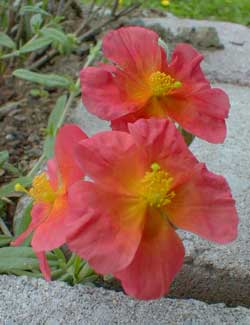
'Fire Dragon'
aka 'Mrs. Clay' Sunrose
"Misery & joy have the same shape in this world:
You may call the rose an open heart or a broken heart."
-Khwaja Mir Dard
(1719-1985)
(1719-1985)
Helianthemum x nummularium 'Fire Dragon' (sometimes rendered 'Firedragon') is a marketing name for the sunrose cultivar 'Mrs. Clay' from the Ness Botanic Garden in England, not awfully far from Liverpool & Chester.
'Fire Dragon' has shimmering bright orange flowers with red hues & yellow eyes, numerous over an evergreen groundcover shrublet of tiny grey-green leaves.
Little clumps spread to eighteen inches during their second year. They can spread further over time but it is a good idea to trim them around the edges to keep them compact, so that weeds will never be able to get established. Late winter is the best time to prune them, before new spring growth begins. They can alternatively be sheered a bit after their first flowering ends in summer, which can induce a milder second bloom.
Ours flowers by the third week in April. It flowers wholeheartedly for April & June, with the possibility of that post-sheering rebloom.
Sunroses are highly drought tolerant & possibly the best groundcover for the xeriscape sun-garden, doing triple-duty as gorgeous foliage-plant, wide range of bright flowering colors, & weed suppression. Although totally neglected sunroses can get rangy with age & too thin at the cneter to keep all the weeds down, periodic sheering keeps them compact & so densely leafed weeds cannot get through.
Sunroses are cold-hardy with the bluish- or grey-green foliaged varieties the most cold-hardy of all. They are even occasionally grown successfully down to Zone 4 (& upward to zone 9). But 'Fire Dragon' like all sunroses is highly intolerant of wetness, & can fail to overwinter not so much from the cold as from winter rains being especially harmful while the shrublet is quiescent.
These shrubs can better tolerate dampness in spring & summer if the soil drains really well, but wet winters can be their bane. All our sunroses grow on rocky ledges & it is extremely rare that I've ever lost one, but I hear complaints of failure from others & have to assume insufficiently sharp drainage in winter is the culprit. With the one proviso of their sensitivity to dampness, I regard them as exceedingly hardy easy plants.